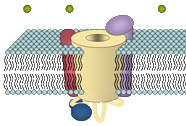 Clara Franzini-Armstrong
Clara Franzini-Armstrong
- homepage -
Department of Cell and Developmental Biology, University of Pennsylvania, Philadelphia, USA
The lab of Clara Franzini-Armstrong has an outstanding expertise in the visualization of EC coupling components using electron microscopy. Her work dramatically influenced our current knowledge about the ultrastructure of the EC coupling apparatus. As a benefit of the synergies of her lab and ours, interesting questions about the mechanisms of tetrad formation - as a prerequisite of skeletal muscle EC coupling - could be answered.
 Kurt Beam
Kurt Beam
- homepage -
Department of Physiology and Biophysics, University of Colorado Medical School, Denver, USA
Kurt Beam's lab unambiguously pioneered EC coupling research in terms of the successful combination of molecular biology, electrophysiology and expression of DHPR α1 chimeras into α1S-null mouse myotubes, a spontaneous k.o. mutation detected years ago. His lab, as a locus of expertise in electrophysiology, cooperated closely with S. Numa's lab (Kyoto University, Japan), - the shelter of cloning ion channel subunits at that time. Already in the pre-PCR period, important findings like the essential role of the skeletal muscle DHPR α1S II-III linker for skeletal-type (Ca2+-independent) EC coupling could be described from chimeric expression studies. Manfred Grabner enjoyed two years of postDoc training (1996 - 1998) in Kurt Beam's lab.
 Robert T. Dirksen
Robert T. Dirksen
- homepage -
Department of Pharmacology and Physiology, University of Rochester Medical Center, Rochester, USA
Robert Dirksen's lab has a high reputation in the research field of skeletal muscle channelopathies; i.e., to understand the cellular abnormalities leading to malignant hyperthermia (MH) and central core disease (CCD), two related human skeletal muscle diseases caused by point mutations in the SR Ca2+ release channel (RyR1), resulting in deranged Ca2+ homeostasis. Bob Dirksen and Manfred Grabner started cooperating and exchanging their electrophysiological and molecular biological expertise, respectively, during their postDoc time in Kurt Beam's lab.
 Francesco Salvatore
Francesco Salvatore
- homepage -
Dipartimento di Biochimica e Biotecnologie Mediche, Università degli Studi di Napoli "Federico II", Naples, ITALY
For several years, the lab of Francesco Salvatore from University of Naples has been focused on the identification of gene loci responsible for malignant hyperthermia susceptibility (MHS) using reverse genetics. Recently, a new mutation on the CACNA1S gene (MHS-5) coding for the DHPR α1S was identified. Using the expertise and tools of our lab, the biophysical properties and physiological consequences of the mutated DHPR were investigated by Antonella Pirone in Grabner's lab.
